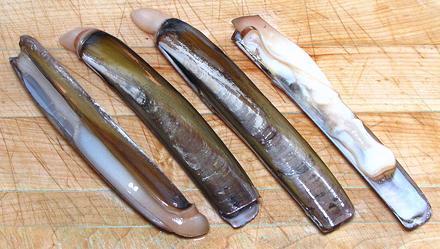Razor Clams
 [Typical culinary species of the four most important genera:
[Typical culinary species of the four most important genera:
Atlantic Jackknife Clam; Ensis directus (North
America, now invading Europe)
Pacific Razor Clam; Siliqua patula (Alaska to Pismo
Beach, California)
Razon Shell; Ensis arcuatus (Eastern Canada,
Northern Europe)
Gould's Razor Clam; Solon strictus (East Asia)]
All the genera listed above look much like the photo specimens, except
the Pacific (Siliqua patula) which is much shorter. Most are
Northern Hemisphere clams, but one species, Navaja (Ensis macha),
inhabits both coasts of South America and is a significant commercial
catch in Chile. Razor Clams feature a digging foot at one end and a
double siphon at the other, Razor clams are very highly regarded as
food but are difficult to catch because they can dig down faster than
a person can dig them up, and some can dig down more than 40 feet.
The photo specimens were purchased live at a large Asian market in
Los Angeles at 2013 US $5.49/pound. They may be Ensis directus
or an almost identical species. The longest was 5.88 inches long
and 7/8 inch wide. They typically weighed 1.63 ounces and yielded 0.63
ounce steamed edible (39%), or $14.08 per edible pound. That's not at
all bad for shellfish around here. The open photo specimen at right in
the photo has been steamed.
More on Bivalve Molusks.
 The specimens in the photo to the left are of typical shape for the
Pacific razor clam, but the one on our West Coast (Siliqua patula)
has a sorter double siphon rather than two elongated siphons. These
specimens were purchased from the frozen food cases at a large Asian
market in Los Angeles at 2009 US $6.29/pound (thawed weight). They
were typically 2.45 inches long and 0.8 inches wide. 8.88 ounces
yielded 2.13 ounces steamed edible (24%) or $26.14 per edible pound.
The specimens in the photo to the left are of typical shape for the
Pacific razor clam, but the one on our West Coast (Siliqua patula)
has a sorter double siphon rather than two elongated siphons. These
specimens were purchased from the frozen food cases at a large Asian
market in Los Angeles at 2009 US $6.29/pound (thawed weight). They
were typically 2.45 inches long and 0.8 inches wide. 8.88 ounces
yielded 2.13 ounces steamed edible (24%) or $26.14 per edible pound.
Buying:
These are not easy to find here in Southern
California, but as noted above, Asian fish markets may have some now
and then. I've seen the live ones for the first time in September
2013, but certainly hope they become a regular item. They are a much
better value than the frozen ones, both for cost per pound and flavor.
Cooking:
Steam them lightly and eat them plain or with
a very light dip. You don't want to screw around with something so
simple and so delicious. Of course you can also use them in seafood
soups. Steam lightly first (to make them easy to shell), shell and cut.
Add to the soup in the last minute to avoid overcooking.
The live specimens (photo at top) were tender and delicious with a
distinctly briny flavor. They are very meaty due to the powerful digging
foot which occupies most of the shell. Note the one at the right that has
been steamed. The dark splotch at left center is the stomach, which is
easy to clean out if you want to bother. Clams are usually eaten stomach
contents and all.
sf_bvrazorz 130914 - www.clovegarden.com
©Andrew Grygus - agryg@clovegaden.com - Photos on this
page not otherwise credited are © cg1 -
Linking to and non-commercial use of this page permitted
 The specimens in the photo to the left are of typical shape for the
Pacific razor clam, but the one on our West Coast (Siliqua patula)
has a sorter double siphon rather than two elongated siphons. These
specimens were purchased from the frozen food cases at a large Asian
market in Los Angeles at 2009 US $6.29/pound (thawed weight). They
were typically 2.45 inches long and 0.8 inches wide. 8.88 ounces
yielded 2.13 ounces steamed edible (24%) or $26.14 per edible pound.
The specimens in the photo to the left are of typical shape for the
Pacific razor clam, but the one on our West Coast (Siliqua patula)
has a sorter double siphon rather than two elongated siphons. These
specimens were purchased from the frozen food cases at a large Asian
market in Los Angeles at 2009 US $6.29/pound (thawed weight). They
were typically 2.45 inches long and 0.8 inches wide. 8.88 ounces
yielded 2.13 ounces steamed edible (24%) or $26.14 per edible pound. [Typical culinary species of the four most important genera:
[Typical culinary species of the four most important genera: